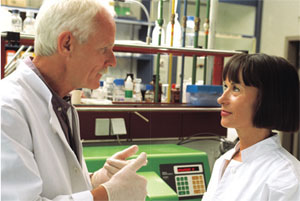Effective laboratory management
You’ve finished your postdoctoral fellowships, your official training period is over and you’ve been hired to head your own laboratory. You are finally the boss! But with this new role comes responsibilities, many of which you may have never done before, and you’re not alone — ScienceCareers.org surveyed principal investigators, postdocs and graduate students and found that 86.6 percent never received formal management training.

Becoming a Ph.D. is mostly about managing your own time. When you are a lab leader, your role is to manage other peoples’ time. Vish Krishnan of the Rady School of Management at the University of California, San Diego, explains, “The day-to-day operation of your laboratory will require both a strong leader and an effective manager. Managers are good at doing things right; leaders do the right things.”
Krishnan adds, “The members of your research team, especially postdocs, are highly educated people. The fundamental challenge is to make them want to do what you want to do. Lab leaders who get good research results show planning, structure and synchronization.”
When you were hired by your institution, you were selected for your scientific excellence and your plans to contribute to an important niche. Now, you have to communicate these goals to your team. “Everybody has to be aware what the laboratory is going after,” Krishnan explains. “A laboratory head is good at setting the direction, as well as defining, decomposing and communicating the work clearly.” A productive and stimulating research environment provides the right overlap between individuals. The challenge for you is to divide up the pieces and be able to put them back together.
Take management training courses
To avoid mistakes as young lab leader, Krishnan recommends attending management courses, such as the San Diego laboratory management symposia organized by the San Diego Postdoc Training Consortium. Already in its third year, the workshops provide postdocs and junior faculty a practical guide for managing their research programs while balancing the demands of a new tenure-track position.
The Rady School of Management also has developed a short executive certificate for scientists at the postdoctoral stage. “We talk about ways to align truth-driven scientific matter and economical goals,” Krishnan explains. “Those two forces seem to be at odds. However, many times the reason for high research costs is that people chase something that is not true and keep doing experiments. If you adjust a process at the right end, you will get results faster and cheaper.”
Manage your time and delegate
Time is very important in both the science and business worlds. Do you schedule your day efficiently? People who are most productive in the morning will do most of their intellectual work before lunch and spend the later part of the day in meetings. People who focus better in the afternoon will do the opposite.
As you move up, you’ll learn to leverage the resources you have. It is impossible to do everything yourself. Delegate and free up your time. To reduce your workload, you have to train your research and administrative staff to take over some of the work. Krishnan explains, “A common mistake is to keep doing what you had been doing before and take on more responsibility. The result is you get overloaded, and projects start waiting for your attention.”
Krishnan also stresses managing your capacity. “Understand what capacity you have available and find the demands on that capacity. The general rule in operations management is not to push your capacity beyond 90 percent, if you want to have an efficient and responsive system. You should have 10 percent slack time built into the plan for creativity and in case an unknown factor requires additional attention. This is easier said than done, because the business world operates on everybody being busy and scheduled for 100 percent of their time. If you want to have relaxed productivity in science, you must learn to delegate. Do less and get more!”
Building a hierarchy helps manage your workload: Project leaders report to the lab head, and senior scientists train junior scientists. “A rule of thumb is that the number of people reporting to you should not be more than seven,” says Krishnan. “Watch out and minimize the bureaucracy that this may create. Weekly prescheduled team meetings save time. You can have regular meetings as early as 7:30 a.m. If everybody knows Thursday morning is discussion time, everybody will prepare their results by Wednesday. You create a natural rhythm, and you will see that synchronization and structure is helpful in getting results.”
Every meeting and commitment has to be questioned: Do I really need to do this? Does the cost-benefit ratio justify the time investment? The laboratory leader also needs some time in the middle of the day for horizontal project management. Even in big groups, at least an hour a day without meetings is essential. How can you keep several projects moving in parallel and jump from one to another without slowing the process? It could happen that a person who is not well trained gets overwhelmed, and the process slows for all participating parties. As you move up in the scientific hierarchy, you must manage projects vertically from start to finish.
Keeping track of all the projects that you are involved with can be challenging. New laboratory-management software, including Web-based tools, can facilitate documentation, data sharing, planning, controlling and synchronization. “It is not very complicated to set up,” says Krishnan. “You can even use a spreadsheet or an electronic calendar to create a pretty good management system. If it becomes a bigger team, you may have to turn to commercial, off-the-shelf software. It is important to facilitate the process and not spend more time organizing the organization tools.”
“Becoming an effective leader is a continuous process of evaluation, trimming and progress,” Krishnan concludes. “In my experience, trimming is something we usually don’t do; we keep adding! In my own research, I try to do more trimming and focus on a few high-impact projects. Prioritization is a key ability to develop over the years. A successful leader in research science understands which projects are the most important for the laboratory and which ones are not worth their time.”
Enjoy reading ASBMB Today?
Become a member to receive the print edition four times a year and the digital edition monthly.
Learn moreFeatured jobs
from the ASBMB career center
Get the latest from ASBMB Today
Enter your email address, and we’ll send you a weekly email with recent articles, interviews and more.
Latest in Careers
Careers highlights or most popular articles

Sketching, scribbling and scicomm
Graduate student Ari Paiz describes how her love of science and art blend to make her an effective science communicator.

Embrace your neurodivergence and flourish in college
This guide offers practical advice on setting yourself up for success — learn how to leverage campus resources, work with professors and embrace your strengths.

Upcoming opportunities
Apply for the ASBMB Interactive Mentoring Activities for Grantsmanship Enhancement grant writing workshop by April 15.

Quieting the static: Building inclusive STEM classrooms
Christin Monroe, an assistant professor of chemistry at Landmark College, offers practical tips to help educators make their classrooms more accessible to neurodivergent scientists.

Unraveling oncogenesis: What makes cancer tick?
Learn about the ASBMB 2025 symposium on oncogenic hubs: chromatin regulatory and transcriptional complexes in cancer.

Exploring lipid metabolism: A journey through time and innovation
Recent lipid metabolism research has unveiled critical insights into lipid–protein interactions, offering potential therapeutic targets for metabolic and neurodegenerative diseases. Check out the latest in lipid science at the ASBMB annual meeting.

